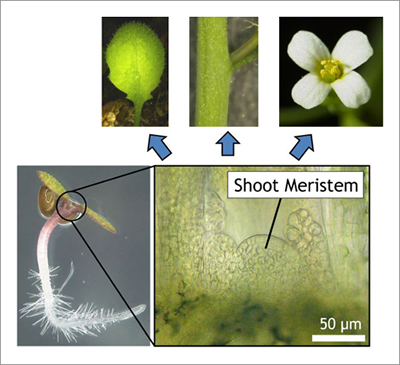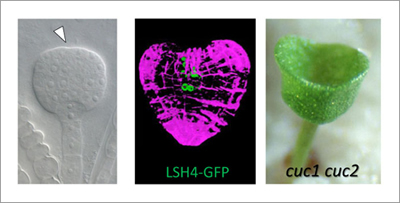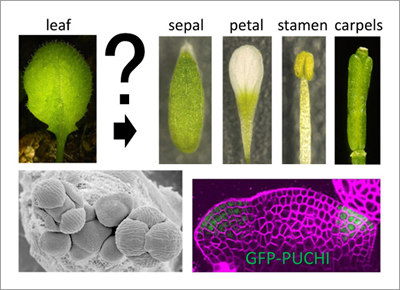Why can plants continuously grow upwards throughout their lifetime? How do plant organs such as leaves and floral organs acquire the diverse shapes that we see around us? To answer these questions, we focus on a small tissue called the shoot meristem, which is located at the tip of the stem (Fig.1). The shoot meristem contains a group of undifferentiated cells in its center. These cells proliferate to produce differentiated organs while they renew themselves to maintain their entity. Cells in the meristem thus possess characteristics of “stem cells”, representing a common strategy for generating complex structures in multicellular organisms. The self-maintaining ability of the meristem is remarkable: in some species, its activity can last for more than a thousand years to produce a tall tree that reaches 100 meters in height. The activity of the shoot meristem is modified upon developmental and environmental cues so that it can produce appropriate types of organs with different shapes. The aim of our research is to understand molecular and cellular mechanisms that control the activity of this fascinating tissue, using the model plant Arabidopsis thaliana.

Fig.1 : Shoot meristem is the source of most aerial organs, such as leaves, stems and flowers.
Major Research Topics
1 ) Shoot Meristem Establishment during Embryogenesis
The shoot meristem is first initiated during embryogenesis (Fig.2). Formation of the embryonic shoot meristem proceeds as a part of embryonic pattern formation and is associated with the activation of factors that are responsible for self-maintaining activity of meristem cells. We focus on the function of CUC1 and CUC2, key transcription factors essential for embryonic shoot meristem formation. These factors are expressed in cells along the boundary of the two cotyledons (embryonic leaves), the site where the shoot meristem arises, and confer these cells characters that are essential for meristem activity. Through identifying genes acting downstream of CUC1 and CUC2 and analyzing what processes they control, we try to understand molecular mechanisms underlying shoot meristem formation during embryogenesis?

Fig.2 : Left: Arabidopsis embryo at the globular stage: The arrowhead indicates the site of shoot meristem formation.
Center: Localization of a protein (green) encoded by one of the CUC1 and CUC2 downstream genes in the heart stage embryo
Right: A mutant that lacks both CUC1 and CUC2 activity: Cotyledons are fused and no shoot meristem is formed.
2 ) Flower Development and Meristem Activity
Majority of the plants that are familiar to us, such as roses, lilies, cherry trees, cereals and sunflowers (and Arabidopsis, too), belong to a group called angiosperms, or flowering plants. The success of this group partly comes from invention of the flower, a highly specialized organ system dedicated for reproduction. Flowers are important not only for plants but also for ourselves, because they provide us with fruit and seed that we daily eat. Floral organs are produced from a specialized type of the meristem called the floral meristem, whose activity differs in many ways from that of the shoot meristem (Fig.3). We focus on a number of genes that control floral meristem activity and try to understand what makes flowers different from other parts of the plant body. We are also interested in development of carpels, which are female reproductive organs with a highly complex structure optimized for pollination, fertilization, seed development and seed dispersal. This research will give us clues to what molecular mechanisms enabled the success of angiosperms.

Fig.3 :Although homeotic genes are known to convert a leaf into any of the floral organs, how they do this is still largely unknown.
Bottom left: The shoot meristem (central dome) produces floral meristems.
Bottom right: PUCHI protein (green) marks two early flower primordia successively produced from the shoot meristem.





